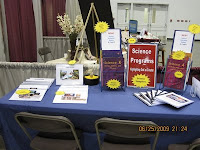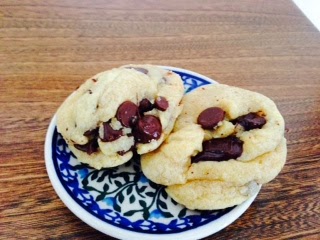 After a busy convention season, I can finally breathe a bit. We just finished my last convention of the year, CHEO in Columbus Ohio. It was a great convention even though our booth was in a very warm spot of the hall. [I kid you not, 20 feet away it was at least 10 degrees cooler, but the circulation in the hall was not efficient at all.]
After a busy convention season, I can finally breathe a bit. We just finished my last convention of the year, CHEO in Columbus Ohio. It was a great convention even though our booth was in a very warm spot of the hall. [I kid you not, 20 feet away it was at least 10 degrees cooler, but the circulation in the hall was not efficient at all.]This was my team on Friday. On Thursday night and Saturday my husband Bob was my fourth member instead of Alicia. We figured we had 18 kids between us.

Left to right: Alicia, Cindy, Shelli and Jill
It all starts with packing up the truck. The display items are heavy and bulky, so it is always a challenge to get everything in the truck--plus all the luggage, computers, pillows and so on for the four of us who go up together. This was taken before we put in the back packs, suitcases and so on.

Then, of course there is in the unloading and the setting up. You would think the convention hall would turn on the air conditioning while the vendors are sweating like crazy carrying and toting and setting up materials, but they don't. They don't turn the air down to a comfortable setting till 4:45 pm-just before the first paying customers come through the door. I actually had to totally chang my clothes at 4:50 because I had sweated up all my clothes. UGH!

We had a steady stream of customers till 9:00 Thursday night. By that time we had had a very full day, so we stopped at Wendy's for supper, headed to the motel and crashed till the morning. I must admit, though, that after a shower, I was already looking forward to Friday.
The next morning we were at the convention hall at 9:00, ready to greet the attendees. We talked to parents who had one child and some that had lots and lots of children. People loved looking at our Core and Science samplers so they could get a real picture of what Sonlight is like. The picture of the samplers was taken Thursday before I plugged in the microscope.
 Many people signed up for the $40 Gift Certificate and Lael of Pataskala, OH won. Lael is a long time SL user and she was really happy to win. Congratulations Lael.
Many people signed up for the $40 Gift Certificate and Lael of Pataskala, OH won. Lael is a long time SL user and she was really happy to win. Congratulations Lael.This is the back of our welcome station, for those who wonder what we keep back there. We keep supplies, water bottles, catalogs, but most importantly we keep our chocolate and our maple pecans.
 We actually ate all the chocolate by the second day so we stopped at Trader Joe's on the way in on Saturday and picked up some dark chocolate covered almonds. If you have never eaten any of these, you are really missing a wonderful way to experience chocolate.
We actually ate all the chocolate by the second day so we stopped at Trader Joe's on the way in on Saturday and picked up some dark chocolate covered almonds. If you have never eaten any of these, you are really missing a wonderful way to experience chocolate. Here is a picture of my husband Bob near the end of the convention on Saturday. Things were very slow and since we hadn't had any customers for while Bob took a break. I call this, "Make Way for Bob." This is proof that Sonlight appeals to all ages. [He is reading the P3/4 Robert McCloskey book].
 All in all it has been a good season. We got to talk to and encourage many nice people. It is always refreshing to see so many committed parents raising up the next generation.
All in all it has been a good season. We got to talk to and encourage many nice people. It is always refreshing to see so many committed parents raising up the next generation.Take care,
Jill












